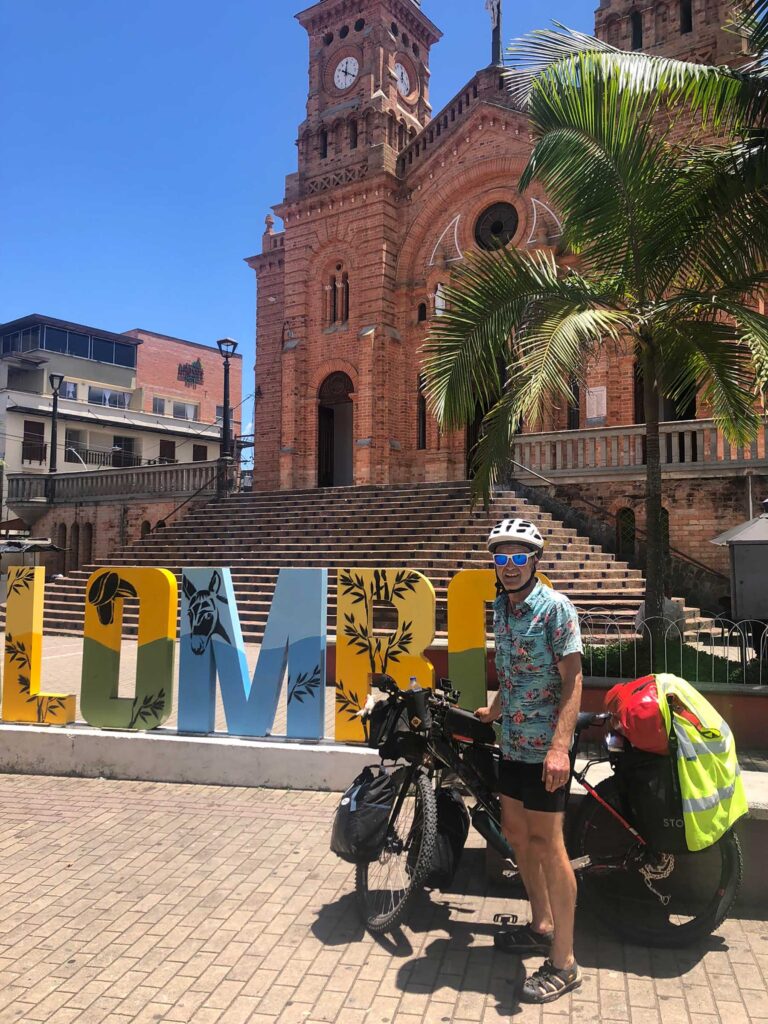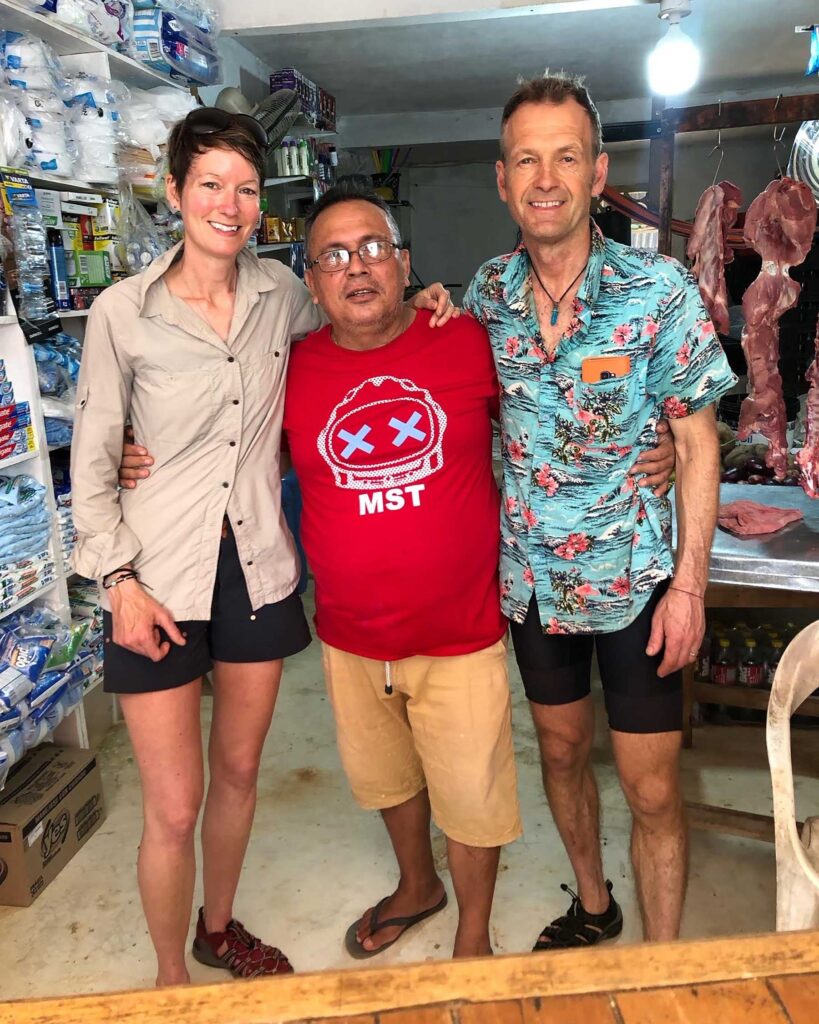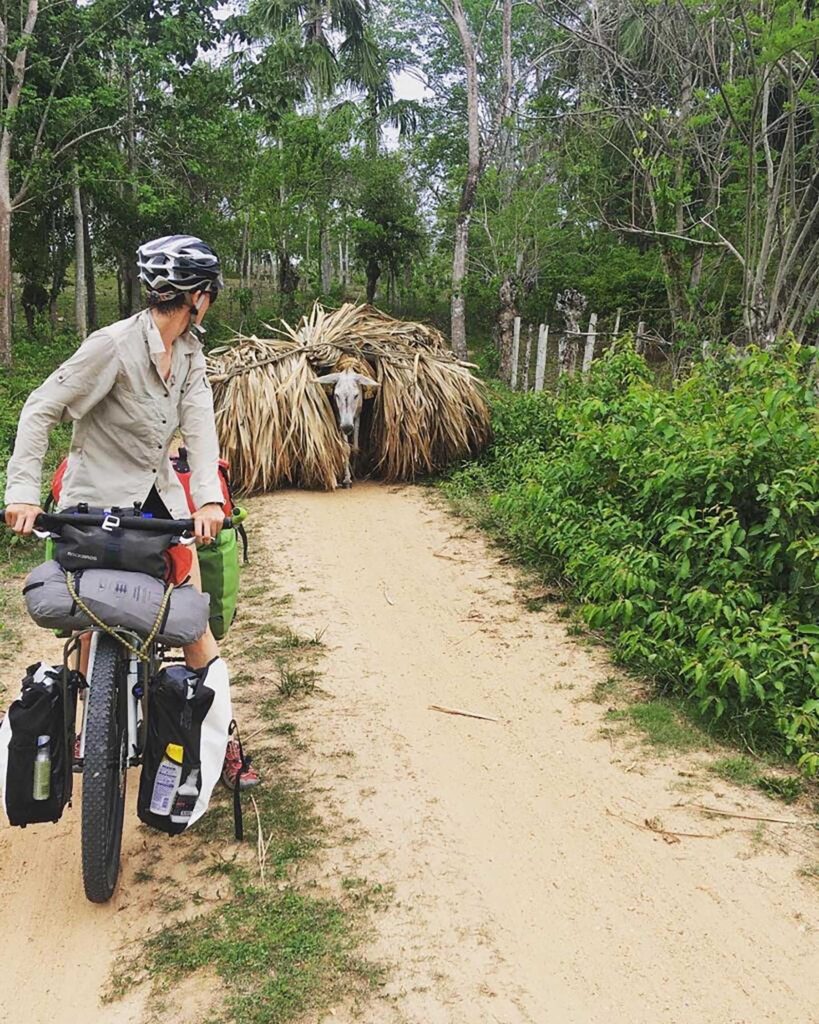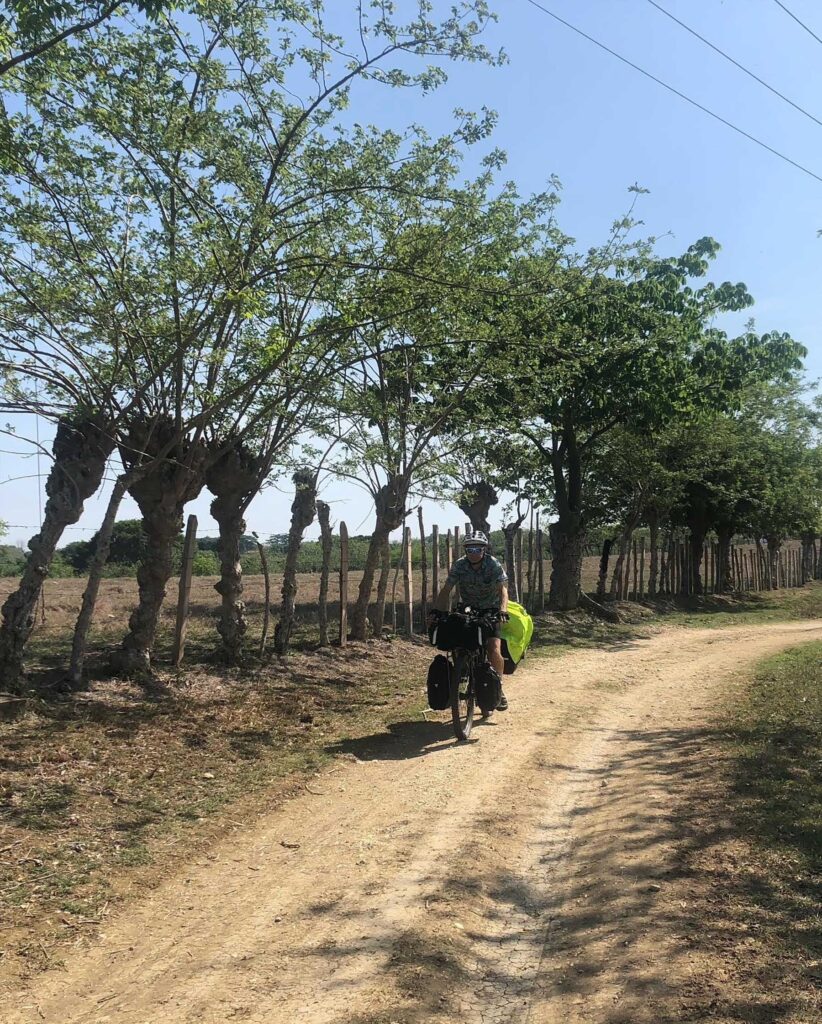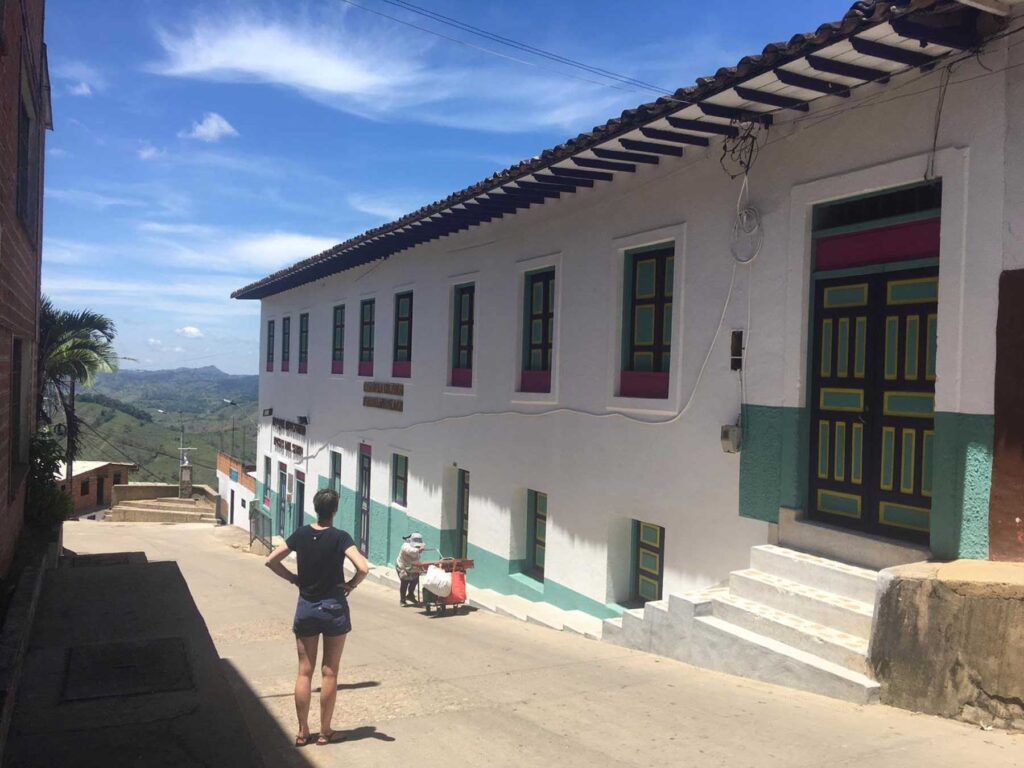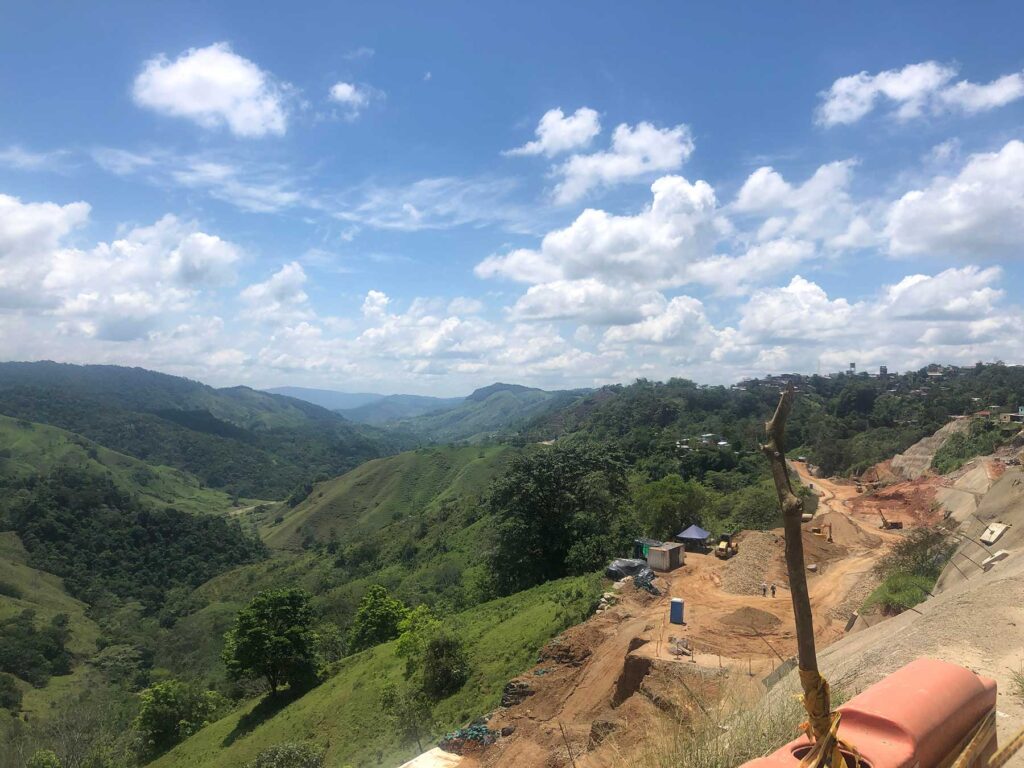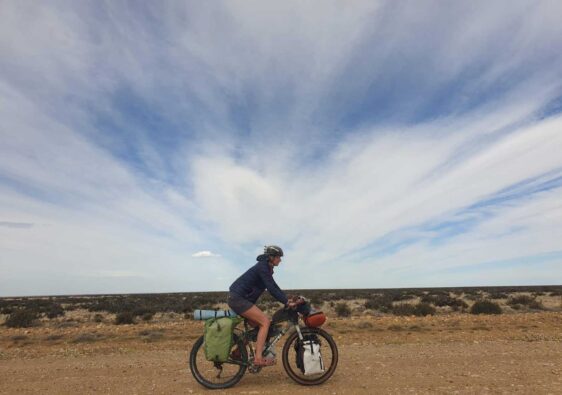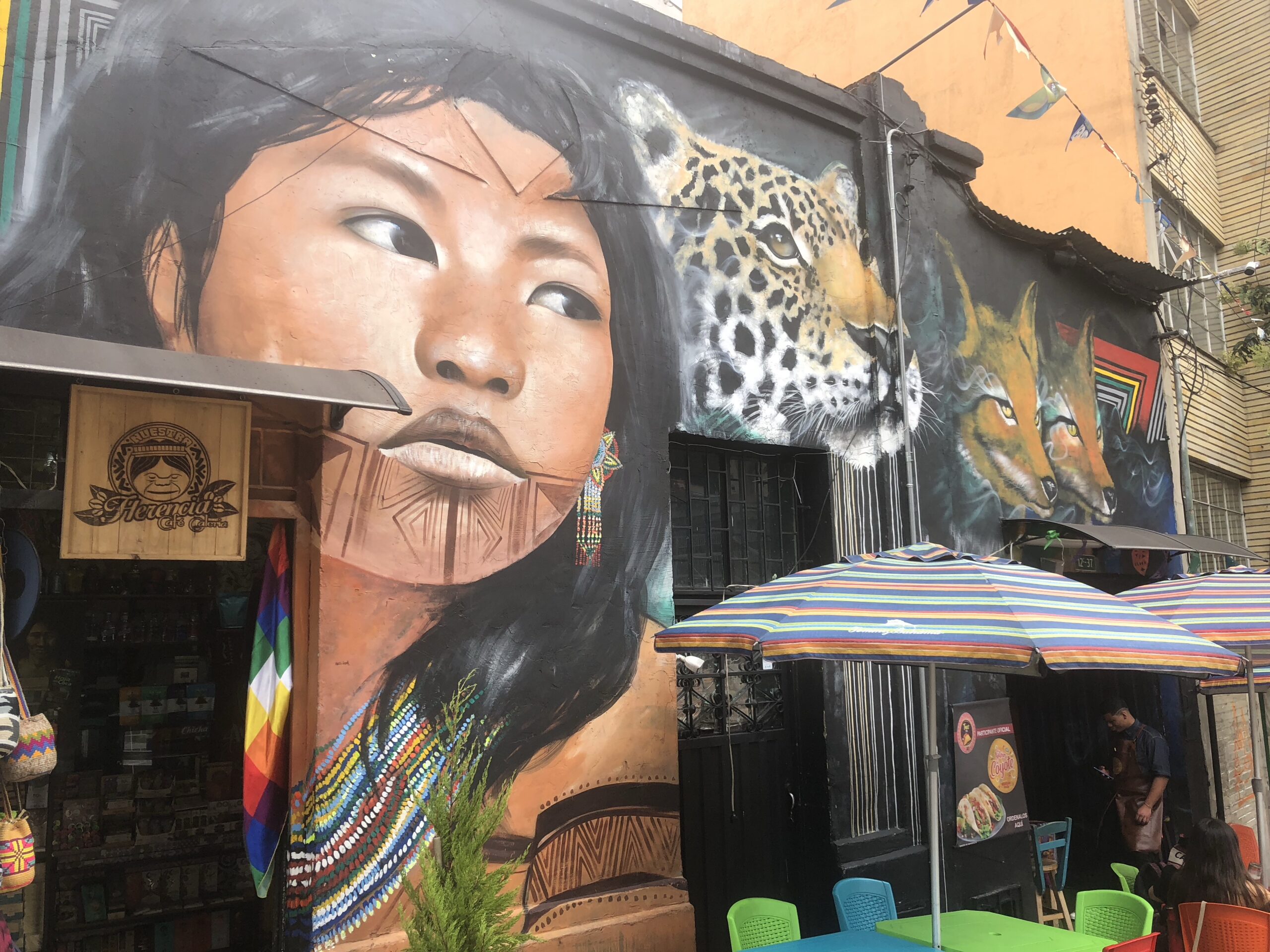The first thing I notice is the weight of the bike, it’s so heavy it’s wobbling, and I’m struggling to stay upright! The next thing is the intense heat, it’s only 9am and already I can feel myself starting to sweat! And then there’s the noise, the city is bustling. Cars, buses and motorbikes beep their horns all fighting for the same space on the road. All these feelings hit me at once like an unwanted emotion I want to escape from. But there’s no going back, the only way out is through, so I take a deep breath and keep cycling, trying to hold my own on the busy roads as we try to escape the city.
For some reason Chris let’s me go in the front, which wasn’t the grand plan in my head, and I wonder why we didn’t discuss this before we left. But I don’t have much time to wonder as the lights turn green and I do my best to wobble across to the right side of the road. I start off in the bus lane, which seems a great idea initially as there are no buses and we speed proudly past all the queuing traffic, but then the loud honk of a horn tells me there’s a bus looming behind so I cross over into the main throng of traffic. Initially I’m terrified as motorbikes weave in between cars and buses, everyone swapping lanes constantly and we are two cyclists squashed in the middle. But I soon relax into it and realise the best thing to do is actually follow the motorbikes as they know how to weave their way through the city. The drivers were courteous and although horns were constantly beeping, no one was angry, this was just their culture.
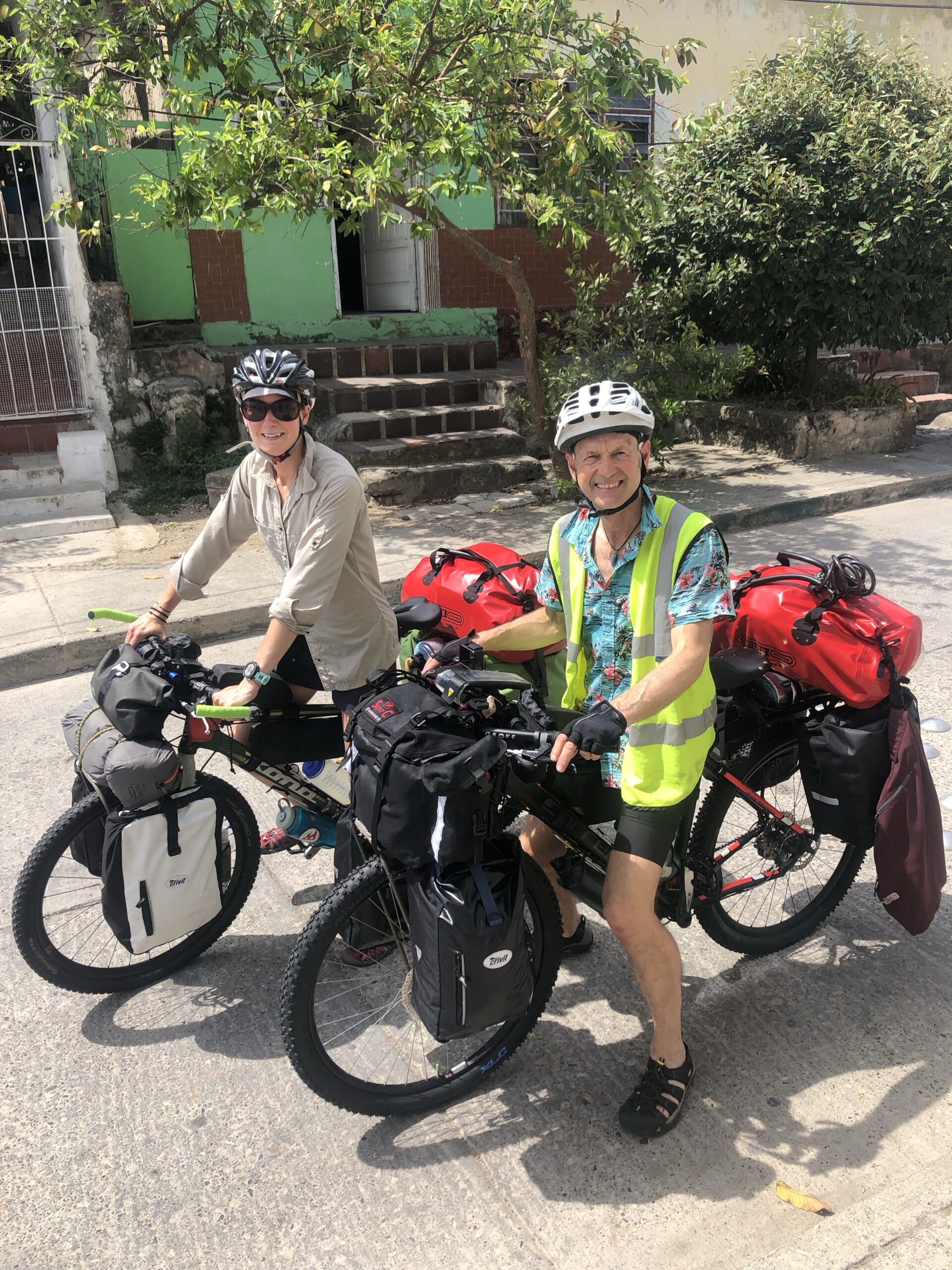
It takes a good two hours to get out of the city, away from the noise and smog, and where the landscape starts to change. The roads were fairly flat fortunately, going downhill with 40kg of extra weight felt like you were flying but the slightest incline and it felt like you were pulling a bus behind you!
The cycling although flat, is really tough, especially in the mid day heat. Our first night we arrive in San Basilio De Palenque – the first free slave town in the whole of the americas. It’s a very Caribbean feel here, the locals are clearly proud of their village and what it stands for, and within 10 minutes of arriving we’re chatting to one of the locals, Ambrosia, who invites us to camp in his garden. His wife cooks us a meal, and his son and girlfriend show us around the village. I say village, but don’t picture a quaint British countryside with a lovely country pub and village shop! It’s fairly big, it’s busy and vibrant, the streets are full of locals chatting, kids cycling up and down the streets practising all kinds of tricks; in this climate why would you sit inside a small stuffy home. The heat doesn’t dissipate as the night rolls in, and we have a restless nights sleep in a hot airless tent that I won’t let Chris open just incase any brave little insects decided to come in and join me! It’s Saturday night so the very loud Caribbean music goes on until the early hours, which is superseded by the barking dog party and finally the cockerels that decide it’s time to wake up at 4.30am!
The barking dogs seem to follow us as we spend a second night in a kind shop keepers back garden in a pretty town called Colomboy. We arrived in Colomboy hot and exhausted, we stopped at the shop for some supplies, Jair asked us where we were going and when we said ‘Argentina’ he rushed away and came back with two chairs and some cold water! We chatted away and when I asked if there was anywhere to camp in the area, there was a quick discussion on this phone with who I presume was his wife, the next minute his shop desk is being moved and our bikes are being wheeled through to the back of the shop! He got his son to bring us a table and two chairs, an extension cable for electric and a light. His son was shy but friendly, and I noticed him a while later with a bowl of water washing his school shirt. The next door neighbour called Lorenzo soon popped his head over and started chatting to us and the next minute Chris is in his back garden with him climbing up his mango tree to collect our desert! I’m truly humbled by the kindness of the Colombians, they’re incredibly friendly and helpful.
We are definitely in the minority around here, and it’s an interesting feeling. But I’m truly humbled by how we’re welcomed by the locals. All of a sudden we’re paying local prices for food, rather than the tourist prices we were paying in Bogota and Cartagena, and locals are genuinely interested in talking to us, and fascinated with our journey, pleased we want to explore their country.
By day three I’ve found my cycling legs and things seem easier. The mornings are definitely the nicest time to cycle, before it gets too hot, so we get up early and make the most of it. By day four, my cycling legs have left me, and my backside is not keen on meeting the saddle again. Following advice from a long distance cyclists blog I read, I decided not to wear cycling shorts as I find them uncomfortable. Apparently after two weeks you’ve adjusted to the pain – either that or it’s so numb you don’t feel any pain at all!
Being vegetarian certainly has its difficulties in Colombia. Soup, for example, even though it’s vegetable soup, tended to have a sneaky bit of pork to surprise me at the bottom! Even asking ‘sin carne et pollo?’ (Without meat or chicken?) with a firm shake of the head from the waitress, it still arrived with some sort of sneaky meat. Chris the flexitarian, however, was more than happy to have two portions of soup! Scrambled eggs also tended to have some little bits of sausage included, and the occasional cheese croissant even had some ham attached. Luckily the mangoes and avocados were definitely vegetarian!
We carry on South, the landscape changing every day. We stop constantly at roadside vendors selling fresh mangoes and avocado which taste divine. Each night we find a different location to camp, day four we end up at the side of a motel behind a petrol station, the owner kindly lets us use the motels shower and toilet, there’s an outside sink next to our tent, perfect! However, the motel which seemed relatively quiet when we arrive at 5pm becomes increasingly busy with buses and truck drivers throughout the night, it was so loud at one point I honestly thought one bus was going to reverse right over our tent! I barely slept and at 5.30am once it was light I grumpily dressed and escaped the heat of the tent. The young security guard that had been there when we arrived last night and was still there over 12 hours later looked at me with a gentle smile and said ‘tinto?’, which meant would you like coffee? My first world problems dissipated as once again the Colombian kindness made me realise how fortunate I was to be experiencing all this.
This genuine kindness continued as we cycled further south, from the traffic diversion lady that tapped me gently on the shoulder, whilst I was waiting for the go sign, and handed me some cold water, to the man in Yali that gave us some bigger puncture repair pads and wouldn’t accept a penny, the man that arrived at our tent with two coffees as we were struggling to put our tent up in the dark, or the young man that stopped his motorbike on a hill and rushed to help Chris pick up his heavy bike after it had fallen down a ditch.
Day five and I’m slowly adapting to the heat, my backside definitely isn’t engaging with the saddle! My hair looks like I’ve constantly just got out of the shower and forgotten my hairbrush, and I’m dripping with sweat constantly. Chris however, still looks perfectly normal, even announcing proudly that he hadn’t washed his hair properly since he’s been here!
Day six and we are both struggling with the heat, it’s 37 degrees in the mid day heat and it doesn’t really drop below 27 degrees at any time of day. The first 12 miles are a real struggle, we can’t find any ‘tiendas’ or cafes to stop and eat so we resort to setting up the stove and cooking ourselves, it takes ages and it’s so hot we can’t escape the sun! The heat is making us tired and agitated, and Chris and I start pulling away from each other rather than working together. It’s 4.30pm and we’ve still got 20km to get to our destination, it’s going to be a long night.
A car pulls alongside us and a man says ‘Hola, where are you from?’. Chris says ‘Inglaterra’ and he invites us to his house for a cold drink. It’s 200m down the road, he gives us cold water and some coffee and says we must stay as long as we want and treat his home like our own. It’s a beautiful Finca with the kitchen and living area outdoors, he gives us a bedroom with a private bathroom and says please help yourself to anything in the kitchen. His name is Luis and we end up staying with him for two nights.
After a good nights sleep, Luis asks us if we’d like to visit his brother and his family and look around his chicken farm. I said yes, as I didn’t want to be impolite, but I was slightly concerned I may have to start plucking chickens to pay for my rent! I presumed his brother lived around the corner, but it turned out his house was 80 miles away, back in the direction we’d come from! But it was a great day, we stopped for lunch and met one of his managers, Joanna, we visited one of his auction sites and eventually arrived at his brothers. Rather than plucking chickens, we spent the afternoon underneath a beautiful outdoor canopy drinking beer and eating mango whilst chatting to one of his sons friends about the local area and where to visit.
On the drive home we stopped at a restaurant for dinner, Luis wouldn’t allow us to pay for a thing all day. Luis spoke good English and so I was able to learn more about Colombia – he told us there was real inequality between the wealthy and the poor, some villages didn’t even have running water, the village closest to his home used his well as their water supply and somebody came up every morning to fill up canisters fir the day. The average wage was $8-10 dollars per day if they were lucky. There was no system for clearing rubbish and so hence why there was so much rubbish piled on the side of the streets in the villages. Education was free and available to every child, but your wealth dictated which school you could go to and the resources available there.
That night back at his house we chatted about his family, he told us he had three sons and one daughter, but that one of his sons had been killed in Medellin through crime. He was separated from his wife and his children grown up and moved on. I didn’t ask too much but I sensed a real sadness and loss, a longing for what once was, a happy and whole family. I knew that feeling well.
I could have stayed much longer, but cycle south we must, and so the next day we continued our bicycle journey. I was overwhelmed not only by Luis kindness but also his complete ease of trust in two complete strangers, to invite us into his home and treat us the way he did for no apparent reason or gain. What freedom lies in that way of living, I wondered. Luis inspired me to try to be more open and trusting in the future, to be more giving and not so suspicious of every stranger that crosses my path.
By day nine we finally find the foothills of the Andes, the 7000km long mountain range we’d come here to cycle. The colours of the green landscape in contrast with the bright blue sky and the yellow birds flying from tree to tree is simply stunning, we cycle alongside rivers which wind gradually up to a hilltop town with a plaza and a church. We cycle through beautiful hilltop towns, including Yali and Yolombo, at 1200m high. We stay overnight in a hostel in Yali, a friendly little town where is seems perfectly normal to see a man sat on a horse outside a bar (surely there’s a joke there somewhere!). The roads became quieter, the hills steeper, and my panniers, it seemed, heavier! As we gained height the temperature reduced slightly but the mid day heat was still relentless. With one problem reducing, along came another. The dogs! So far most dogs had been very friendly and if they weren’t they were tied up. Now in the countryside they didn’t need to be tied up and they seemed to take a liking to the legs of cyclists! As you got closer they would suddenly bark like mad then chase you down the street. You were supposed to shout and scream louder so they knew you were the boss and they would back off. This worked quite well until we were cycling up a steep hill, and already out of breath, an overweight fierce looking canine decided to chase us! Fortunately Chris had some energy and screamed something incomprehensible at it which seemed to work! I noticed with the afternoon heat most dogs had no energy left, and you would simply get a one eyed look and perhaps a twitch of a leg if you were lucky.
After twelve days of cycling we finally reach Medellin, the second largest city in Colombia. It’s crazy cycling into the city. Like any city, it’s incredibly loud and busy, but it’s also hot and hilly, the adrenaline flows as once again we weave in and out of the traffic trying to find our way to our hotel. Medellin, once listed as one of the most dangerous cities in the world, is now a vibrant and diverse place to explore. I’m looking forward to a few days rest before we head off south west to explore the Eje Cafatero region (coffee axis), the main coffee growing region in Colombia! I’ve been excited to explore this area for some time, not only because of the coffee obviously but also to see the famous wax palms in the beautiful Valle de Cocora, these are the tallest palm trees in the world and can grow to 200 feet in height.
If you only visited the touristy areas of Colombia, you may mistakingly think it’s a relatively rich country, but we are fortunate enough to travel through the ‘real’ colombia. We learn and experience real beauty. Before we left, so many people warned me to be careful in Colombia, it indeed has a reputation for being one of the most dangerous countries in the world. In fact this statement couldn’t be more wrong, it’s possibly one of the friendliest countries I’ve ever had the privilege of travelling through.

